SUBFAMILY MYRMICINAE - Genus Pristomyrmex
| The Ants of
Africa SUBFAMILY MYRMICINAE - Genus Pristomyrmex |
|
| Contents - Myrmicinae - MYRMICINAE Introduction |
In Tribe MYRMECININI.
Diagnostic Features - Head broader in front than behind, sides convex. Distal portion of mandible in anterior view suddenly broadened. Median portion of clypeus with a number of blunt teeth on the anterior margin; lateral portions reduced to a thin raised strip in front of the antennal insertions. Antennae 11-segmented, with a 3-segmented club. Eyes medium or small, about the midlength of the head. Dorsum of alitrunk without sutures. Pronotum usually with a pair of spines or blunt tubercles. Propodeum bispinose or bidentate. Sting simple, without an apical spatulate lamella.
Mayr's (1866b) genus description is at ![]() .
.
According to Bolton (1973a) the genus could be confused with some species of Xiphomyrmex (now synonymised with Tetramorium) but the sting has no spiculate apical portion. Members nest in rotten wood or fallen twigs in the leaf litter, foraging in the same area.
Revised by Bolton (1981b). Most species are leaf litter dwellers, nesting in rotten wood.
Key to workers known from Africa
| 1 | 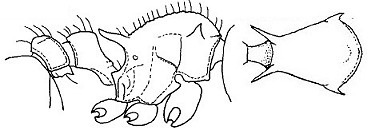 TL 3.2-3.4 mm; petiole and postpetiole with
lateral coarse sculpture; the only species with quite dense short
pilosity; head behind the eyes with projecting short hairs; brown,
gaster darker than head and alitrunk, appendages lighter TL 3.2-3.4 mm; petiole and postpetiole with
lateral coarse sculpture; the only species with quite dense short
pilosity; head behind the eyes with projecting short hairs; brown,
gaster darker than head and alitrunk, appendages lighter |
. |
| . | 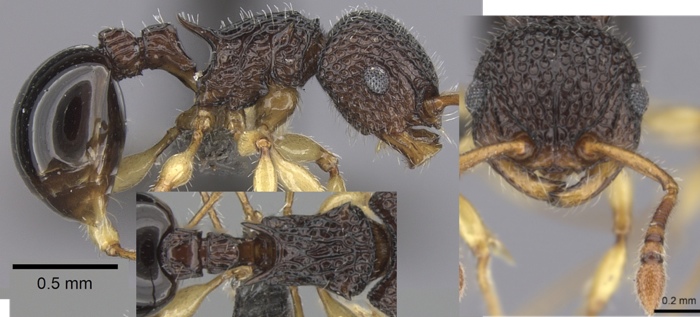 |
southern Africa - cribrarius |
| -- | Petiole and postpetiole with sides smooth and shining; head behind the eyes without projecting short hairs | 2 |
| 2 | 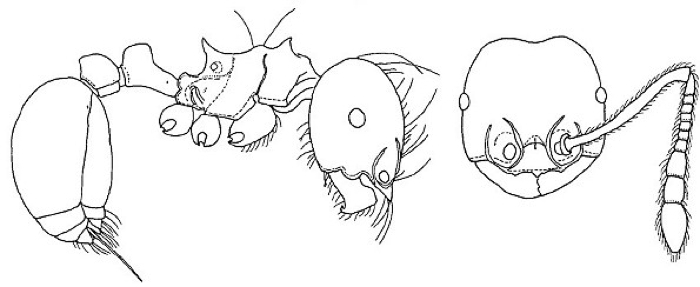 TL
3.4-4.0 mm; without frontal carinae and very short frontal lobes;
scapes reaching occiput (SI 101); shiny chestnut brown TL
3.4-4.0 mm; without frontal carinae and very short frontal lobes;
scapes reaching occiput (SI 101); shiny chestnut brown |
. |
| . | 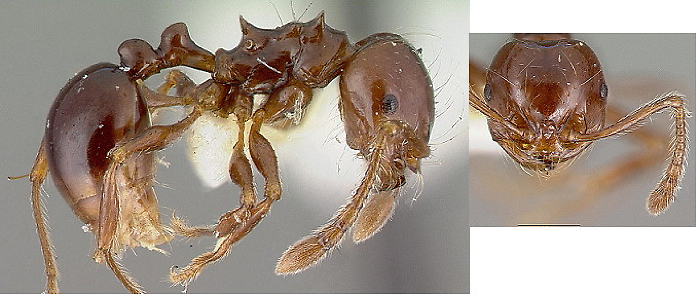 |
Eastern Zaire - trogor |
| -- | With distinct frontal carinae; scapes shorter (SI 82-90) | 3 |
| 3 | With small eyes and pronotum armed with distinct sharp teeth or spines | 4 |
| -- | With relatively large eyes (8-10 ommatidia long); pronotum with no more than low tubercles | 5 |
| 4 | 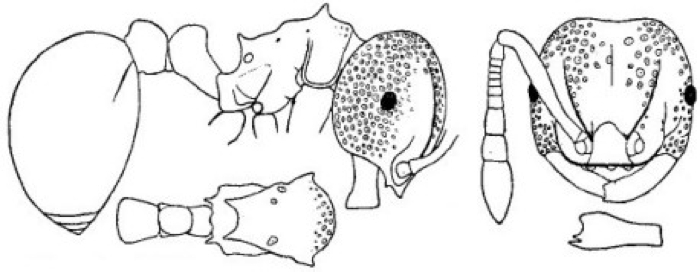 TL
2.7-3.4 mm, CI 97-104, SI 85-94; antennal
scapes distinctly sinuous with an out-turned apex; spines on pronotum
and propodeum only moderately long and generally not very sharp; head
with quite abundant foveae and semi-erect pilosity; colour varying from
orange-brown to blackish-brown, gaster often darker TL
2.7-3.4 mm, CI 97-104, SI 85-94; antennal
scapes distinctly sinuous with an out-turned apex; spines on pronotum
and propodeum only moderately long and generally not very sharp; head
with quite abundant foveae and semi-erect pilosity; colour varying from
orange-brown to blackish-brown, gaster often darker |
. |
| . |  |
western Africa, south to Angola - africanus |
| -- |  TL
3.2 mm, CI 104, SI 78; almost wholly unsculptured, except for minute
hairs pits on the front of the head; mandibles apparently with distinct
teeth; antennal scapes near straight; pronotum with long acute spines
that are very narrow in frontal view; shiny, dark red brown with
distinct lighter areas, notably on the frons and pedicel TL
3.2 mm, CI 104, SI 78; almost wholly unsculptured, except for minute
hairs pits on the front of the head; mandibles apparently with distinct
teeth; antennal scapes near straight; pronotum with long acute spines
that are very narrow in frontal view; shiny, dark red brown with
distinct lighter areas, notably on the frons and pedicel |
Tanzania (Usambara Mts) - new
species - usambarensis |
| 5 | 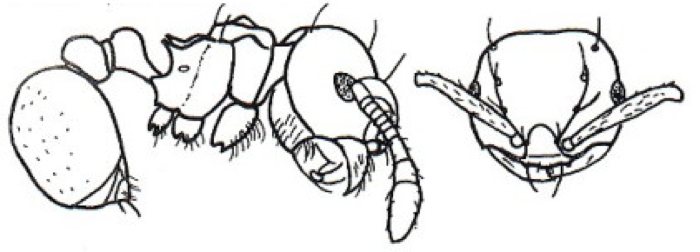 TL
2.9-3.4 mm, head wider than long, CI 100-106, SI 80-87; front of head
smooth and shining; eye moderate; profile of petiole node not
wedge-shaped; blackish-brown to black TL
2.9-3.4 mm, head wider than long, CI 100-106, SI 80-87; front of head
smooth and shining; eye moderate; profile of petiole node not
wedge-shaped; blackish-brown to black |
. |
| . | 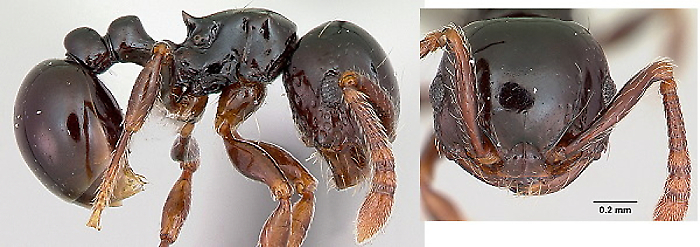 |
western Africa, south to Angola - orbiceps |
| -- |  TL
2.7-3.2 mm, CI (Bolton) 95-97; front of head with distinct fovea; eye
ca 0.25 HW; clypeus with sharp median carina; profile of petiole node
wedge-shaped; shiny light brown TL
2.7-3.2 mm, CI (Bolton) 95-97; front of head with distinct fovea; eye
ca 0.25 HW; clypeus with sharp median carina; profile of petiole node
wedge-shaped; shiny light brown |
South Africa - fossulatus |
| MYRMICINAE Introduction |
© 2007, 2008, 2010, 2013 - Brian Taylor CBiol FSB FRES 11, Grazingfield, Wilford, Nottingham, NG11 7FN, U.K. |
href="pristomyrmex.htm"